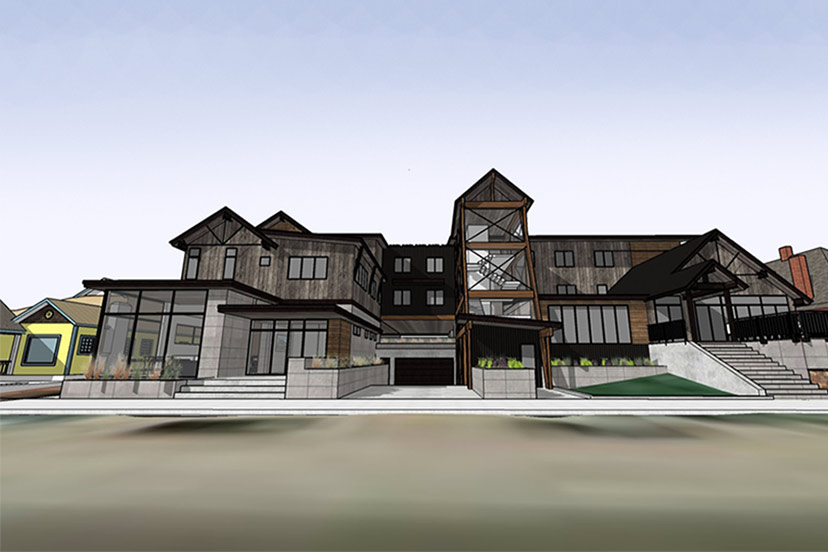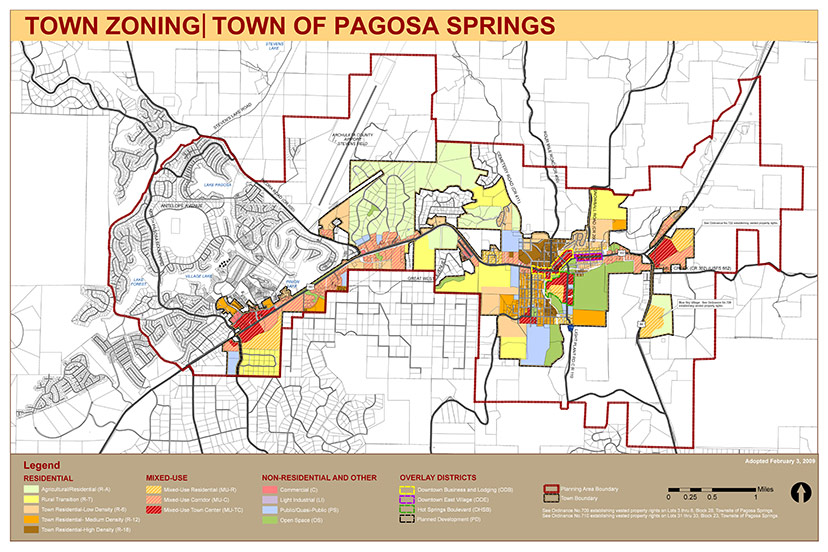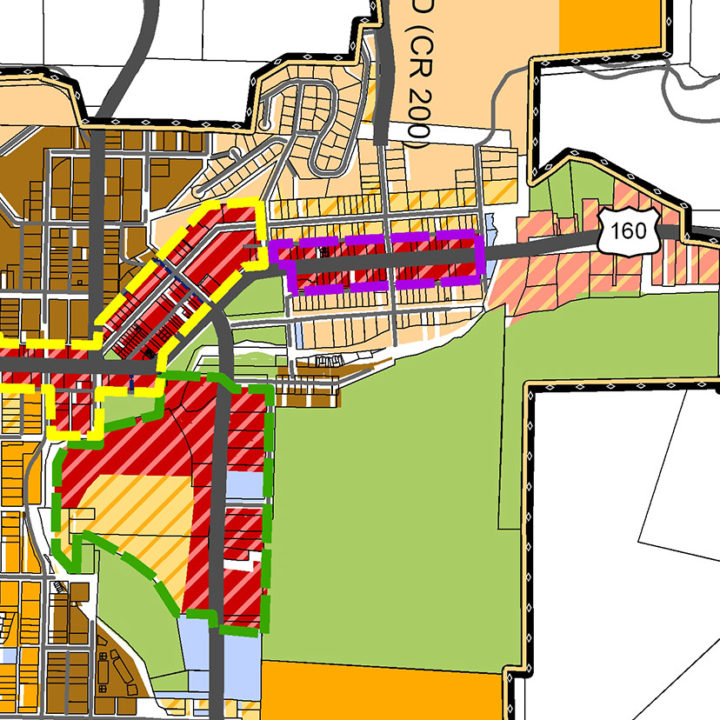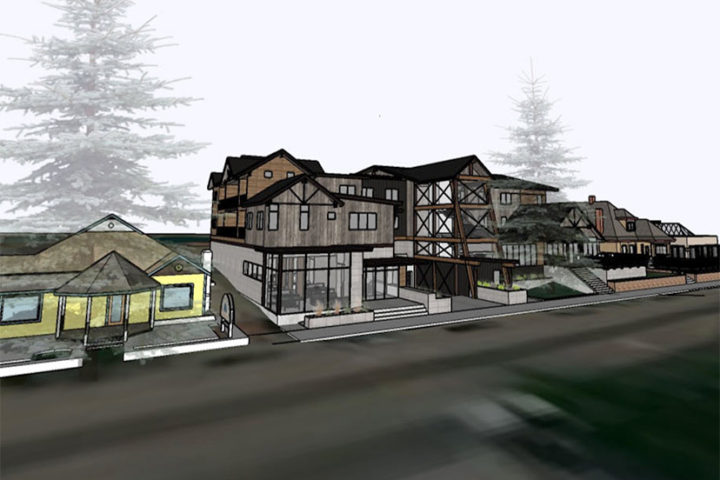Following a 25-minute summary of the problems and promises of intensive development in the “East Village” section of downtown Pagosa Springs, presented by Town Planner Cindy Schultz, and following some preliminary questions about the proposal from the Planning Commission members…
Chris Pitcher, Peter Adams, Mark Weiler, Kristen McCollam and Julie Gurule, plus alternate member Chad Hodges…
…the two lead architects on the project sat down at the presenters’ table, facing the Commission, to give an overview of the Pagosa Street Development, and to field more questions.
I’ve never personally tried to design a 43,800-square-foot building to fit — and hopefully, enhance — the character of an existing neighborhood like the “East Village”. I can imagine it takes quite a bit of mental and creative energy.
I can imagine how it feels to have a Planning Commission reject your idea.
Several years ago, the Town modified its approval process to include a “Sketch Plan” review, with the idea that the Planning Commission (acting as the Design Review Board) would give developers and architects some preliminary input, about their concerns, while the project was still in a “sketch” — while the project was still “conceptual”. This was the review that took place last night.
The process also allows public comment, and last night, July 12, we heard a good deal of public comment, primarily from the neighboring property owners in the “East Village”.
As many Daily Post readers know, the East Village includes the now-mainly-commercial district along Highway 160 (also known, quaintly, as Pagosa Street) between N. 3rd Street and N. 1st Street. The district was originally residential, with one church and one motel in the neighborhood… with sidewalks. (Sidewalks are somewhat rare in downtown’s residential districts.) Over the past 50 years, nearly all the residential homes have been converted to commercial use, but the Town government, in its wisdom, determined that the “feeling” of a residential neighborhood ought to be preserved through land use regulations.
So the district was officially zoned with an “overlay”.
The East Village Overlay.
Here is the zoning map of the Town of Pagosa Springs, with its numerous and various zoning areas:
The zoning attempts to preserve, to some degree, the “character” of the different neighborhoods, but without completely and explicitly defining, and limiting, future development.
Here’s the map, focused around the East Village Overlay, outlined in a purple dashed line:
While the map illustrates the physical boundaries of the East Village, the Land Use and Development Code (LUDC) defines the “character” that the Town government wants to preserve, as words.
3.5.2. DOWNTOWN EAST VILLAGE OVERLAY (ODE)
The ODE Overlay is established to accommodate less intense commercial uses such as small offices, restaurants, individual retail stores, galleries, and other uses of similar impact. The Town also hopes to maintain and utilize the older homes existing in the district for commercial and residential uses. New residential uses are permitted, but commercial uses are encouraged.
The core question before the Planning Commission, last night, July 12, was: does this proposed building meet the requirements written in the Land Use and Development Code?
Some of the LUDC requirements are simple to assess. For example: the ‘height’ of a building in downtown Pagosa Springs is limited to 40 feet. According to Ms. Schultz, the sketched building — as presented by architects Lauren Davis and Brad Ash, of Reynolds Ash & Associates — does in fact align with the LUDC’s height limitations. Just barely, it would seem.
But does the sketch show a building that aligns with the intent of the East Village Overlay zoning?
The audience unanimously felt that it did not align.
During public comment, we heard from property owners Kristin Skeehan, Randall Davis, Trish Davis, Tim Ludwig, Kathy Keyes, Robert Nemeth, Sarah Nemeth, and Yours Truly (me).
Quite a bit of the discussion, among the Commissioners and among the public, concerned parking. How would this ratehr massive development, with its new office (to be occupied by Reynolds Ash & Associates, we were told) and its new Restaurant, and its eight proposed condo units, accommodate all the vehicles that might need to park nearby or within the underground parking garage?
Recently, the Town modified its LUDC to remove requirements that new commercial development within the town provide a specific amount of parking spaces. The new regulations still require new residential and lodging uses to provide parking spaces. Since the Pagosa Street Development is proposing mixed uses — commercial and residential — the architects provided parking for the residential units, but not necessarily for the commercial uses.
However, as noted by numerous people last night, the project will eliminate the ‘vacant lot’ parking currently used by the Alley House Grille immediately east of the proposed project. Where will those customers park? (We note that the Alley House is owned by the same folks who own the three vacant Pagosa Street Development parcels, and who would presumably be part owners of the proposed project?)
But we also had this ‘subjective’ rule:
3.5.2. DOWNTOWN EAST VILLAGE OVERLAY (ODE)
The ODE Overlay is established to accommodate less intense commercial uses such as small offices, restaurants, individual retail stores, galleries, and other uses of similar impact.
If we look at the words “less intense” we probably need to ask: “less intense than what?”
Perhaps, “less intense than the rest of downtown Pagosa Springs”? But this project, as proposed by the architects, would be perhaps the “most intense” land use anywhere in downtown Pagosa. In no practical sense can the architects describe their proposal as “less intense”.
We also read “small offices, restaurants, individual retail stores, galleries and other uses of similar impact.” These words suggest the intention of the LUDC to preserve a certain “character” in the East Village.
In the end, it was the massive scale of the project — compared to neighboring uses — that led the Planning Commission to tell the architects to come back, next month, with a drawing that fits better into the neighborhood.
We understand that Pagosa Springs is facing significant growth pressures currently. (The coming recession might ease those pressures, but who can say?)
How should those growth pressures be handled?




